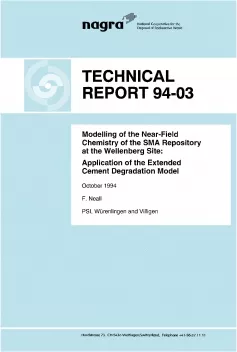
Technical Report NTB 94-03
Modelling of the Near-Field Chemistry of the SMA Repository at the Wellenberg Site: Application of the Extended Cement Degradation Model
Of the materials which make up the L/ILW repository for short-lived low- and intermediate-level wastes, around 95 weight percent consists of concrete, around 4 % of steel and around 1 % of high molecular weight organic waste components. In this report, models are used to evaluate the long-term stability of concrete, steel and high molecular weight organic components under repository conditions. The results of this study will then form the basis for describing release of radionuclides from the disposal caverns, and particularly the sorption of nuclides on concrete.
In the disposal caverns, concrete is exposed to a range of processes which affect its stability. External processes include the leaching of hydrated cement by percolating groundwater, while internal processes include dissolution of repository components in cement porewater which can then react with the concrete. Of greatest significance in this respect are the high molecular weight organic waste components which degrade to organic acids in the disposal environment and then react with the basic components of the concrete.
The leaching of hydrated cement is described, using a mixing tank model, as a sequence of batch experiments in which the same cement block reacts repeatedly with fresh groundwater. The model is based on the work by Berner (1990) but has been extended to include other solid cement phases and can, in a simple way, take account of the degradation of high molecular weight organics and their reaction with hydrated cement. The mixing tank model shows that, given the low water fluxes that are expected for a L/ILW repository, concrete remains stable over geological time spans provided only small volumes of high molecular weight organics are present. If high concentrations of these materials are present, the longevity of the concrete may be reduced.
The redox conditions in the disposal caverns are determined mainly by the corrosion of steel. In the first decades following repository closure (aerobic phase), corrosion processes consume the oxygen present in the repository until only traces are left. Once the oxygen has been consumed, anaerobic corrosion of steel and other metal components takes place over several thousands of years; the redox conditions during this phase are strongly reducing. Once all the metals in the repository have corroded, the redox state will adjust gradually to that of the inflowing groundwater.
